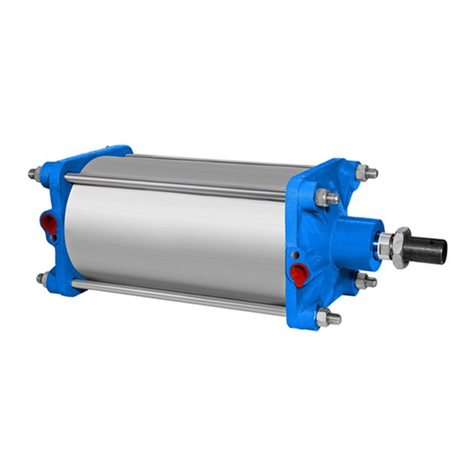Metso Nordberg GP200S User manual

Instruction manual
140548

1RUGEHUJ *36VHULHV
VHFRQGDU\ &RQH &UXVKHUV
This instruction manual is valid for Nordberg GP200S-series secondary cone crushers
manufactured by Metso Minerals from the year 1999 and the serial number of xxxx. The crusher
is a high capacity cone crusher, which is intented to be used in secondary crushing applications
in big and medium size crushing plants.
Because of the continuous development of the product, the manufacturer reserves a right to alter
the technical specifications written in this manual, without any advance information.
This is the first edition published in December 1999 in Tampere, Finland.
Manufacturer:
Metso Minerals
P.O. Box 306
33101 Tampere
Finland
Tel. +358-204 84 142
Fax +358-204 84 143
Instruction manual GP200S
11/02 140548

Table of Contents
1. PREFACE . . . . . . . . . . . . . . . . . . . . . . . . . . . . . . . . . . . . . . . . . . . . . . . . . . . . . . . . . 1-1
2. SAFETY. . . . . . . . . . . . . . . . . . . . . . . . . . . . . . . . . . . . . . . . . . . . . . . . . . . . . . . . . . . 2-1
3. GENERAL. . . . . . . . . . . . . . . . . . . . . . . . . . . . . . . . . . . . . . . . . . . . . . . . . . . . . . . . . 3-1
3.1 CRUSHER TERMINOLOGY . . . . . . . . . . . . . . . . . . . . . . . . . . . . . . . . . . . . . . . . . . 3-1
3.2 NORDBERG GP200S-SERIES CONE CRUSHER. . . . . . . . . . . . . . . . . . . . . . . . . . 3-2
3.3 OPERATING PRINCIPLE. . . . . . . . . . . . . . . . . . . . . . . . . . . . . . . . . . . . . . . . . . . . . 3-2
3.4 MAIN COMPONENTS . . . . . . . . . . . . . . . . . . . . . . . . . . . . . . . . . . . . . . . . . . . . . . . 3-3
3.5 TECHNICAL SPECIFICATIONS . . . . . . . . . . . . . . . . . . . . . . . . . . . . . . . . . . . . . . . 3-4
3.6 SPARE AND WEAR PARTS. . . . . . . . . . . . . . . . . . . . . . . . . . . . . . . . . . . . . . . . . . . 3-5
3.7 APPLICATIONS. . . . . . . . . . . . . . . . . . . . . . . . . . . . . . . . . . . . . . . . . . . . . . . . . . . . . 3-6
3.8 CAPACITY. . . . . . . . . . . . . . . . . . . . . . . . . . . . . . . . . . . . . . . . . . . . . . . . . . . . . . . . . 3-7
3.9 SETTING RANGE . . . . . . . . . . . . . . . . . . . . . . . . . . . . . . . . . . . . . . . . . . . . . . . . . . . 3-8
3.10 CAVITY SELECTION. . . . . . . . . . . . . . . . . . . . . . . . . . . . . . . . . . . . . . . . . . . . . . . . 3-9
4. INSTALLATION . . . . . . . . . . . . . . . . . . . . . . . . . . . . . . . . . . . . . . . . . . . . . . . . . . . 4-1
4.1 FOUNDATION. . . . . . . . . . . . . . . . . . . . . . . . . . . . . . . . . . . . . . . . . . . . . . . . . . . . . . 4-1
4.2 INSTALLATION DIMENSIONS . . . . . . . . . . . . . . . . . . . . . . . . . . . . . . . . . . . . . . . 4-2
4.3 SPACE REQUIREMENTS FOR MAINTENANCE . . . . . . . . . . . . . . . . . . . . . . . . . 4-4
4.4 LIFTING THE CRUSHER AND ITS PARTS . . . . . . . . . . . . . . . . . . . . . . . . . . . . . . 4-5
4.5 FEEDING THE CRUSHER . . . . . . . . . . . . . . . . . . . . . . . . . . . . . . . . . . . . . . . . . . . . 4-6
4.6 REMOVAL OF CRUSHED MATERIAL . . . . . . . . . . . . . . . . . . . . . . . . . . . . . . . . . 4-7
4.7 POWER TRANSMISSION. . . . . . . . . . . . . . . . . . . . . . . . . . . . . . . . . . . . . . . . . . . . . 4-8
4.8 HOSES . . . . . . . . . . . . . . . . . . . . . . . . . . . . . . . . . . . . . . . . . . . . . . . . . . . . . . . . . . . 4-10
4.9 OVERLOAD PROTECTION. . . . . . . . . . . . . . . . . . . . . . . . . . . . . . . . . . . . . . . . . . 4-11
4.10 TRANSPORT . . . . . . . . . . . . . . . . . . . . . . . . . . . . . . . . . . . . . . . . . . . . . . . . . . . . . . 4-12
4.11 SPECIAL TOOLS. . . . . . . . . . . . . . . . . . . . . . . . . . . . . . . . . . . . . . . . . . . . . . . . . . . 4-12
4.12 WELDING . . . . . . . . . . . . . . . . . . . . . . . . . . . . . . . . . . . . . . . . . . . . . . . . . . . . . . . . 4-13
4.13 CORROSION PREVENTION . . . . . . . . . . . . . . . . . . . . . . . . . . . . . . . . . . . . . . . . . 4-13
4.14 SERVICE PLATFORM . . . . . . . . . . . . . . . . . . . . . . . . . . . . . . . . . . . . . . . . . . . . . . 4-14
4.15 SETTING CONTROL . . . . . . . . . . . . . . . . . . . . . . . . . . . . . . . . . . . . . . . . . . . . . . . 4-14
4.16 PRESSURIZED DUST SEALING. . . . . . . . . . . . . . . . . . . . . . . . . . . . . . . . . . . . . . 4-14
5. CRUSHING . . . . . . . . . . . . . . . . . . . . . . . . . . . . . . . . . . . . . . . . . . . . . . . . . . . . . . . . 5-1
5.1 BEFORE STARTING. . . . . . . . . . . . . . . . . . . . . . . . . . . . . . . . . . . . . . . . . . . . . . . . . 5-1
5.2 STARTING. . . . . . . . . . . . . . . . . . . . . . . . . . . . . . . . . . . . . . . . . . . . . . . . . . . . . . . . . 5-1
5.3 STOPPING . . . . . . . . . . . . . . . . . . . . . . . . . . . . . . . . . . . . . . . . . . . . . . . . . . . . . . . . . 5-1
5.4 RUNNING-IN. . . . . . . . . . . . . . . . . . . . . . . . . . . . . . . . . . . . . . . . . . . . . . . . . . . . . . . 5-2
5.5 OPERATION . . . . . . . . . . . . . . . . . . . . . . . . . . . . . . . . . . . . . . . . . . . . . . . . . . . . . . . 5-4
5.6 SETTING . . . . . . . . . . . . . . . . . . . . . . . . . . . . . . . . . . . . . . . . . . . . . . . . . . . . . . . . . . 5-5
5.7 STROKE . . . . . . . . . . . . . . . . . . . . . . . . . . . . . . . . . . . . . . . . . . . . . . . . . . . . . . . . . . . 5-5
Instruction Manual GP200S
12/99 140548

6. LUBRICATION . . . . . . . . . . . . . . . . . . . . . . . . . . . . . . . . . . . . . . . . . . . . . . . . . . . . . 6-1
6.1 COUNTERSHAFT. . . . . . . . . . . . . . . . . . . . . . . . . . . . . . . . . . . . . . . . . . . . . . . . . . . . 6-1
6.2 TOP BEARING . . . . . . . . . . . . . . . . . . . . . . . . . . . . . . . . . . . . . . . . . . . . . . . . . . . . . . 6-1
7. PERIODICAL MAINTENANCE. . . . . . . . . . . . . . . . . . . . . . . . . . . . . . . . . . . . . . . 7-1
7.1 EVERY 8 RUNNING HOURS/EVERY WORKING SHIFT . . . . . . . . . . . . . . . . . . . 7-1
7.2 AFTER 40 HOURS OF OPERATION/ EVERY WEEK (1-SHIFT OPERATION). . 7-2
7.3 EVERY 300 HOURS OF OPERATION/ EVERY MONTH (2-SHIFT
OPERATION)/EVERY SECOND MONTH (1-SHIFT OPERATION) . . . . . . . . . . . . . . . . 7-3
7.4 EVERY 2000 HOURS OF OPERATION/EVERY YEAR (1-SHIFT
OPERATION)/EVERY HALF YEAR (2-SHIFT OPERATION). . . . . . . . . . . . . . . . . . . . . 7-4
7.5 SEASONAL MAINTENANCE (SUMMER/WINTER) . . . . . . . . . . . . . . . . . . . . . . . 7-4
7.6 EVERY 20 000 HOURS OF OPERATION/EVERY 10 YEARS (1-SHIFT
OPERATION)/EVERY 5 YEARS (2-SHIFT OPERATION). . . . . . . . . . . . . . . . . . . . . . . . 7-4
7.7 MAINTENANCE INTERVALS . . . . . . . . . . . . . . . . . . . . . . . . . . . . . . . . . . . . . . . . . 7-5
8. REPLACEMENT OF LINERS. . . . . . . . . . . . . . . . . . . . . . . . . . . . . . . . . . . . . . . . . 8-1
8.1 GENERAL . . . . . . . . . . . . . . . . . . . . . . . . . . . . . . . . . . . . . . . . . . . . . . . . . . . . . . . . . . 8-1
8.2 DISMANTLING THE CRUSHER . . . . . . . . . . . . . . . . . . . . . . . . . . . . . . . . . . . . . . . 8-2
8.3 REPLACING THE CONCAVE. . . . . . . . . . . . . . . . . . . . . . . . . . . . . . . . . . . . . . . . . . 8-4
8.4 REPLACING THE MANTLE . . . . . . . . . . . . . . . . . . . . . . . . . . . . . . . . . . . . . . . . . . . 8-6
8.5 ASSEMBLING THE CRUSHER. . . . . . . . . . . . . . . . . . . . . . . . . . . . . . . . . . . . . . . . . 8-8
8.6 AFTER TIGHTENING . . . . . . . . . . . . . . . . . . . . . . . . . . . . . . . . . . . . . . . . . . . . . . . . 8-9
9. OTHER MAINTENANCE . . . . . . . . . . . . . . . . . . . . . . . . . . . . . . . . . . . . . . . . . . . . 9-1
9.1 GENERAL . . . . . . . . . . . . . . . . . . . . . . . . . . . . . . . . . . . . . . . . . . . . . . . . . . . . . . . . . . 9-1
9.2. REPLACING THE TOP BEARING SEAL. . . . . . . . . . . . . . . . . . . . . . . . . . . . . . . . . 9-2
9.3 REPLACING THE DUST SEAL. . . . . . . . . . . . . . . . . . . . . . . . . . . . . . . . . . . . . . . . . 9-3
9.4 THRUST BEARING . . . . . . . . . . . . . . . . . . . . . . . . . . . . . . . . . . . . . . . . . . . . . . . . . . 9-4
9.5 CHANGING THE STROKE . . . . . . . . . . . . . . . . . . . . . . . . . . . . . . . . . . . . . . . . . . . . 9-5
9.6 REPLACING THE TOP BEARING . . . . . . . . . . . . . . . . . . . . . . . . . . . . . . . . . . . . . . 9-7
9.7 REPLACING THE PROTECTIVE SLEEVE OF THE MAIN SHAFT . . . . . . . . . . . 9-8
9.8 GEAR BACKLASH. . . . . . . . . . . . . . . . . . . . . . . . . . . . . . . . . . . . . . . . . . . . . . . . . . . 9-9
9.9 PROTECTION PLATES . . . . . . . . . . . . . . . . . . . . . . . . . . . . . . . . . . . . . . . . . . . . . . 9-12
9.10 REPAIR INSTRUCTIONS . . . . . . . . . . . . . . . . . . . . . . . . . . . . . . . . . . . . . . . . . . . . 9-12
10. TROUBLE SHOOTING . . . . . . . . . . . . . . . . . . . . . . . . . . . . . . . . . . . . . . . . . . . . . 10-1
GP200S Instruction Manual
140548 12/99

!#
This instruction manual is intended to assist
owners and users of Nordberg products in the
proper use of the equipment.
It includes important references to safe,
proper and economical operation of the
equipment. Following these instructions will
help to avoid possible danger, reduce repair
costs and breakdowns and to increase the
reliability and life of the equipment.
This manual must be complemented by those
instructions necessary because of existing
national mandatory rules relating to accident
prevention and environmental protection.
A copy of this manual must be kept at the
equipment’s location and made available to
the operators as required.
In addition to this manual and accident
prevention regulations mandatory in the
country ofuse and atthe equipment’s place of
operation, generally recognized rules for safe
and professional operation must be observed.
Thisinstruction manualmustbereadandused
by each person who works with the
equipment, typically:
—operations, including installation, startup,
operation, application engineering,
materials handling, site labour,
environmental engineering and safety
departments.
—maintenance, including inspection and
repair.
—transport, materials handling and rigging.
Note that this instruction manual contains
information and instructions on alternative
and optional equipment. Normally the
machines have only some of them. Before
maintaining and servicing, find out which
alternative and optional equipment your
machine has.
See separate instruction manuals for more
detailed instructions when servicing the main
components.
There may beoptionalequipment which have
separate instruction manuals. Those manuals
must be read and used by each person who
works with the equipment.
Preface
1/95 1-00-B 1-1

6$)(7<
WARNING SYMBOLS
The following symbols for particularly
important instructions are being used in the
instruction manual:
Reference
Refers to economical operation of the
equipment.
Attention
Particular attention must be given to prevent
possible incorrect or dangerous operating
situations from occurring.
Danger
Particular attention must be given to prevent
accidents or damage to personnel and/or
property.
PERSONNEL SAFETY
This portion of the instruction manual is
intended to illustrate only basic safety
procedures. Additional precautions may be
necessary for the safe operation of a Crusher.
The information contained in this manual is
notintendedtoreplacesafety codes,insurance
requirements, federal, state and local laws,
rules and regulations.
SAFETY of the operator and maintenance
personnel is of prime concern. These
paragraphs are presented as a helpful guide to
construction equipment personnel and shows
some of the daily work problems which they
may encounter.
It is the responsibility of the operator to know
what specific requirements, precautions and
work area hazards exist and to discuss them
withhissupervisor.A commonunderstanding
should be reached by all personnel to assure
safe performance in operating the equipment.
Theoperatoristhekeytosafejobperformance
and should study these safety tips to be aware
of basic safety precautions to help prevent
serious injury and damage to property.
STOP ACCIDENTS BEFORE THEY STOP
YOU!
In order to alert you, the user, and those
entrusted as operators and maintenance
personnel, dangerous or hazardous operations
are shown in this instruction manual with
WARNING notes.
The safest machine must still be operated with
care and with knowledge of its performance
capabilities. The most comprehensive safety
program must still be followed.
Safety
12/97 2-01-B 2-1

Remember that on any job, YOU are the key
to safety. Good safety practices not only
protectthemenaroundyou, they areyourown
best protection. Study this manual and any
manufacturer’s operator’s manuals covering
yourspecificequipment.Readallwarningand
caution instructions. Practice safe operation.
INSISTTHATYOURFELLOWWORKERS
DO, TOO. BE ALERT TO POSSIBLE
HAZARDS BEFORE THEY CAUSE
TROUBLE,AND REMEMBER...SAFETY
IS UP TO YOU!!!
DO YOU KNOW YOUR EMPLOYER’S
SAFETY PROGRAM?
Company safetyrecordsshowthatthe greatest
percentage of accidents are caused by
disregard of simple safety rules.
Know-observe!-the overall program . . . and
consult your supervisor for specific
instructions when starting a job.
ARE YOU DRESSED PROPERLY FOR
THE JOB?
You may need any number of special items -
safety hat, safety shoes, safety glasses,
goggles, heavy gloves, ear protective devices,
etc., - for your own protection. Find out what
items are required and wear them!
Loose clothing can catch in moving parts.
Keep sleeves buttoned, jackets belted and
wear your special safety equipment. Keep
warm without restricting your movement.
Wrist watches and rings can be dangerous.
Keep your pockets free of objects which may
fall out.
DO YOU UNDERSTAND YOUR
MACHINERY?
READ THE MANUAL furnished with your
equipment to learn its operating and
maintenance characteristics, capacities and
limitations. Learn the location and function of
ALLcontrols, indicators,warningdevicesand
caution instructions.
DO YOU HAVE KNOWLEDGE OF
WORKING AREAS?
Learn − beforehand as much about your
working area as possible:
Be a good housekeeper . . . keep the floor
clean, free of oil, grease, rags, cables, chains,
buckets, rocks and other hazards. Keep loose
parts in a tool box. Use only non-flammable
solutions for cleaning.
Know the weight limitations for any floors on
which you will operate.
Know the clearances in the work area. A little
time spent checking side and overhead
clearances, including power lines, can save a
lot of trouble later.
Be careful of dust, smoke or fog, which may
obscure your vision.
ARE YOU PREPARED FOR
EMERGENCIES?
Plan ahead - stay alert - operate sensibly - and
you will avoid both having and causing
personal injury and accidental equipment
damage. If a careless moment does cause an
emergency - react quickly with the tools and
skills at hand. Know the location of and how
to use a fire extinguisher and a first aid kit.
Know where to get prompt assistance.
An emergency calls for fast action.
DON’T STOP YOUR SAFETY PROGRAM
WITH THESE GENERAL RULES. BE
EQUALLY CONSCIOUS THAT SPECIFIC
WORKING CONDITIONS AND YOUR
PARTICULAR EQUIPMENT - CAN
REQUIRE ADDITIONAL PRECAUTIONS.
BEFORE STARTING CHECK
Equipment not properly prepared for
operation is unsafe equipment. Run a careful
checkatthebeginningofyourshift.Ifyoufind
Safety
2-2 2-01-B 12/97

something that needs attention, THINK
TWICE before deciding to "let it go this time".
Even minor mechanical defects can lead to
personal injury and accidents.
1DO NOT allow unauthorized personnel
to operate the Crusher!
2MAKE SURE all guards and other
protective devices are in place, secured
and not damaged.
3CHECK fluid systems: Are they at the
correct level and completely leak free?
4CHECK every drain cock, valve and
fitting to sure it is in place and secure
5Loss of pressure from low fluid levels
may lead to serious hydraulic failures.
6CRUSHER SEIZURE from lack of oil
or grease is a problem that may cause
accidents.
7NEVER tamper with safety devices.
8CHECK the Crusher thoroughly for
visual defects, such as leaks, worn hoses
or loose parts.
9INSPECT your machine according to
the operator’s manual and your
supervisor’s instructions.
10 BEFORE STARTING walk completely
around your machine. Make sure there
is no one next to under or on the
machine. Warn any personnel nearby
that you are starting up.
REPORT ANY DEFECTS TO YOUR
SUPERVISOR
START UP SAFELY
1CHECK equipment for warning tags.
2FOLLOW the recommended starting
procedure as outlined in Section 5
OPERATION.
3AFTER Crusher has been started, check
all gauges and instruments to be sure
that everything is operating properly.
4SHUT DOWN immediately if any
improper readings are observed.
5TEST all controls for proper
functioning.
6LISTEN for and report any unusual
noises.
7RE-CHECK alarms or other warning
and safety devices.
8DO NOT stand on the Crusher while
the Crusher is running.
9DO NOT lean or place your hands on
or against the tension spring while the
Crusher is in operation.
10 DO NOT take a chance with a defective
machine. REPORT IT TO YOUR
SUPERVISOR.
REPORT A DEFECTIVE MACHINE
Inspectyourmachinedaily. ..checkforloose,
worn or damaged parts. Report or correct any
unsafe conditions immediately . . . and do not
operate the machine until they have been
corrected.
Even a minor defect can become serious . . .
report any machine defects to your supervisor.
STOPPING SAFELY
Besure Crusheris stoppedbefore .. .cleaning,
servicing,lubricating.. .checking belttension
. . . removing housing covers . . . working on
the hydraulic system . . . making repairs . . . or
attempting to clear a plugged cavity. MAKE
NO CHECKS, ADJUSTMENTS OR
REPAIRS OF ANY KIND WHILE
CRUSHER IS IN OPERATION.
TIPS FOR SAFE MAINTENANCE
Perform maintenance with care.
READ AND UNDERSTAND
1Instruction manual furnished with the
Crusher, especially Section 5,
OPERATION.
2Instructions for inspection and
maintenance located in Section 5
OPERATION and 7 PERIODICAL
MAINTENANCE.
Safety
12/97 2-01-B 2-3

3Warning and caution plates provided on the
machine.
4Warning and caution notes in the
instruction manual.
5Lubrication guides for periodic
servicing in Section 6, LUBRICATION.
WARNING TAGS
BeforeworkinginsideaCrusher,be suretotag
and lockout the electrical controls so no one
else will start it.
Attach warning tags to prevent accidents:
1If Crusher is unsafe for operation.
2If controls are being serviced.
3If machine is being repaired.
LOCKOUT ELECTRICAL SERVICE
1Always lockout all electrical controls
before performing any type of
maintenance work on the Crusher.
2Provide each maintenance man with
his own personal padlock and ONE key.
CLOTHING - SAFE PRACTICE
1KEEP HANDS AND CLOTHING
AWAY FROM MOVING PARTS. Do
not take chances by wearing loose
sleeves, floppy ties, watches and rings.
2WEAR EYE PROTECTION when
handling fuel, cleaning fluid, oil or
brake fluid. THESE MATERIALS CAN
DAMAGE YOUR EYES.
3WEAR A RESPIRATOR when
required.
4WEAR SAFETY GLASSES when
drilling, grinding or hammering metal.
5KEEP YOUR POCKETS FREE of
objects which can fall out and into
machinery.
6WEAR HARD HAT AND SAFETY
SHOES, when required.
7WEAR GLOVES to protect your
hands when changing cables.
8WEAR SAFETY GLASSES AND
PROTECTIVE CLOTHING when
using high pressure air.
9WEAR GOGGLES AND
PROTECTIVE CLOTHING when
handling molten metals; zinc, babbitt,
lead, etc.
10 WEAR EAR PROTECTIVE DEVICES
when required or REDUCE exposure
time as required.
ALCOHOLIC BEVERAGES AND
MEDICATION
1DO NOT use alcoholic beverages
before coming to work or while on the
job.
2BEWARE of medicines, tranquilizers
or other drugs which can make you
sleepy or less alert.
WORK AREA
1PROMOTE GOOD HOUSEKEEPING,
keep the floor clean and dry, free of
debris and tools. Oily and wet floors,
steps and hand rails are slippery. In
winter watch out for ice and snow. Wet
spots, especially near electrical
equipment, are dangerous.
2DO NOT let material lay and build up
on or around the Crusher.
3STORE dangerous fluids in a suitable
place - away from unauthorized
personnel. ALLOW NO SMOKING IN
THE AREA!
4NEVER start a diesel or gasoline engine
within an enclosed area unless there is
adequate ventilation. Exhaust fumes can
kill!
EQUIPMENT
1Use the proper tools; handle tools and
heavy parts sensibly.
2Keep all tools and equipment free of
dirt, oil and grease. Do not drop or toss
them.
3Use hoisting equipment for heavy lifting.
Safety
2-4 2-01-B 12/97

Save your back.
4Lower parts, do not drop them.
5To prevent slipping, wipe hand levers
and knobs clean of oil or grease.
6Do not use sheaves with cracked rims
or spokes.
7Check for missing, cracked or frayed
V-belts.
8Check for broken, defective or missing
parts and replace them. Keep equipment
clean and free of dirt and oil so you can
spot loose or defective parts.
9When using cables to move a load, be
sure cables are of adequate size and
replace any worn, badly frayed, broken
or kinked ones. Check end connections
for wear.
FIRE HAZARDS
1DO NOT smoke while refueling - or
when handling fuel containers.
2SHUT OFF engine when refueling -
and use extra caution if engine is hot.
3WHEN pouring fuel into the tank,
ground the funnel or spout against the
filler neck to avoid static electric spark.
4DO NOT use gasoline or diesel fuel
for cleaning parts. Good commercial,
non-flammable solvents are preferred.
5DO NOT smoke while using cleaning
solvents.
6DO NOT let greasy, oily rags
accumulate in poorly ventilated area.
Store oily rags and other combustible
material in a safe place.
7NEVER use an open flame to check
fuel, battery electrolyte or coolant levels
. . . or to look for hydraulic leaks
anywhere on the equipment.
Use a flashlight!
8KNOW where fire extinguishers are
kept - and how they operate - and for
what type of fire. Check regularly - at
least monthly - to be sure it is in the
working area.
PRESSURIZED SYSTEMS -
HYDRAULIC OR AIR
1Relieve ALL pressure before opening
or removing any hydraulic or air
pressure lines, valves, fittings, etc.
2Check for worn hoses or damaged lines.
3High pressure oil can be dangerous.
USE QUALITY PARTS
Areplacementpart foranyitemshould always
be of comparable SIZE, TYPE AND
QUALITY - as the part being discarded.
REPORT NECESSARY REPAIRS
If your daily check uncovers any item that
need attention - repair, replacement or
adjustment - REPORT IT NOW!
The most minor defect could result in more
serious trouble - IF THE MACHINE IS
OPERATED.
Only perform the work you’re authorized to
do. Do not attempt repairs you do not
understand.
Only work on equipment you thoroughly
understand - a pressure-loaded part, if
carelessly released could injure anyone in its
path.
Remember you are entrusted with the
operation and maintenance of a highly
valuable piece of equipment TREAT IT AS
SUCH!
Safety
12/97 2-01-B 2-5

5(0(0%(5
6$)(7<,68372<28
PLANT SAFETY
The safety procedures mentioned here do not
eliminate all safety hazards found in the area
ofcrushingplants.However,they dohighlight
someofthe procedureswhichhavebeenfound
through long experience to improve safety
conditions around Crushers and crushing
plants. Nordberg will welcome inquiries
regarding other suggested safety procedures
for use around their Crushers and related
equipment.
DRIVE GUARDS
Proper safety precautions start with the initial
installationoftheCrusher.Crushersaredriven
either by V-belts or by direct couplings to
motors. THE BELT DRIVE OR COUPLING
SHOULD HAVE A PROTECTIVE GUARD
AROUND IT.
Crusher-sheaves in particular are designed for
maximum rim speeds. If these speeds are
exceeded it is possible that the sheave could
explode and cause severe injury or even death.
Since the speed of the Crusher is quite
important for proper operation, most V-belt
drive guards usually have a small opening
immediately opposite the center of the crusher
drive shaft so that a tachometer can be inserted
to occasionally check the speed of the
eccentric shaft. This opening should be
covered with an access door or hatch.
OPERATOR’S PLATFORM
Since periodic inspection and maintenance
must be performed on each Crusher, IT IS
IMPORTANT THAT SOME TYPE OF
PLATFORM BE ERECTED AT A LEVEL
CONVENIENT FOR THE MAINTENANCE
MEN WHO MUST INSPECT AND WORK
ON THE CRUSHER. A good operator’s
platform constructed of "solid" floor plate
should have hand railings, toe plates and wire
mesh or expanded metal between the platform
and the top of the hand railing to prevent tools
from dropping off the platform and hitting
someone working below. Do not fasten the
operator’s platform to the Crusher.
ELECTRICAL LOCKOUT
THE ELECTRICAL POWER SOURCE FOR
THE CRUSHING EQUIPMENT SHOULD
BE LOCKED OUT WHENEVER ANYONE
IS WORKING ON IT. Each maintenance man
who normally works on a Crusher should be
provided with his own personal padlock with
onlyone key.When heworksonanyassembly
of the Crusher, he should use this padlock to
lock out the electrical controls for the Crusher.
It is most important that only one key be
provided for the lock and that key must be in
the pocket of the person who isworking on the
Crusher. If more than one person worksonthe
Crusher, each should have his own lock and
keyatseparatelockoutstationsforthecontrols
of the Crusher.Accidental start-up of crushing
equipment with men in the immediatearea can
beresponsiblefor manyaccidentsonwhatwas
supposedly a "clear" machine.
CRANES
Crushers, like any other type of mechanical
equipment, require normal periodic
maintenance if the operator is to get the most
for his money from the use of the machine.
One of the most flagrant Crusher safety
violations is the use of inadequate and unsafe
lifting equipment. Although a Crusher is not a
finely tuned piece of equipment, such as an
Safety
2-6 2-01-B 12/97

automobile engine, the internal parts of a
Crusher should be assembled and
disassembledwithcranefacilitiesthathavethe
capability of gently and slowly lifting and
lowering the various parts that make up a
Crusher. WHEN USING A CRANE,
ALWAYS OPERATE WITHIN THE
RATED CAPACITY OF THE CRANE. THE
SAFE RATED CAPACITY INCLUDES
WEIGHT OF HOOK, BLOCK AND ANY
MATERIALS HANDLING DEVICES
SUCH AS CABLES, SLINGS, SPREADER
BARS,ETC.SUBTRACTTHE WEIGHTOF
ALLTHESE TOFINDTHETRUEWEIGHT
OF THE LOAD THAT CAN BE HANDLED
SAFELY. Chain falls should be considered
only as a last resort to assemble and
disassemble a Crusher. When it comes to
safety, the best should be used.
MOBILE CRANES
WHEN USING A MOBILE CRANE,
ALWAYS OPERATE WITHIN THE
RATED CAPACITY OF THE MACHINE
TO AVOID BUCKLING THE BOOM OR
TIPPING. Safe ratings are based on operating
the crane on firm, level ground; outriggers
should be properly extended and/or lowered
whenever possible. Avoid fast swings, hoists
or sudden braking; these can cause overloads.
Do not handle large, heavy loads in strong
winds.
When moving your crane, check bridges
before crossing, make sure they will support
the weight of the machine. Check clearances
under bridges for overhead electrical lines or
any overhead obstruction.
Check your hitcher, be sure he’s clear before
starting lift. Make certain he securely attaches
the load.
TORCH CUTTING EQUIPMENT
One of the most frequently used tools around
the Crusher is the cutting torch. Crushers
which are equipped with hydraulic
components should have these components
depressurized and adequately covered with
flame-proof material so that sparks, weld
spatter, etc., cannot reach these areas.
Ruptured high pressure hydraulic lines will
quickly vaporize the hydraulic fluid as it
reaches the atmosphere. This vaporized fluid
canquicklybecomeamassofflames,resulting
in severe burns for personnel in the immediate
area. ALL MAINTENANCE PERSONNEL
WHO NORMALLY USE TORCH
CUTTING EQUIPMENT SHOULD BE
ADVISED IF THERE ARE HYDRAULIC
COMPONENTS IN THE IMMEDIATE
AREA IN WHICH THEY ARE WORKING.
Then adequate precautions be made to avoid
contact with these components. Rubber lined
hoses are not immune to the torch cutting
equipment which is used in normal plant
maintenance procedures.
CONVEYOR BELTS
DO NOT USE CONVEYOR BELTS AS
WALKWAYS. Conveyor belts leading to and
from the Crusher should be provided with
walkways alongside the conveyor. Always
provide hand rails along the conveyor belt
walkway as an added safety precaution.
PORTABLE PLANTS
If the crushing plant consists of portable
equipment, that is, crushing and screening
equipment mounted on trailers, trailer footing
or cribbing is extremely important for safe
operation. Check your footing. Your machine
should be on a solid and level a footing as
possible. Use heavy timber mats as needed.
Trailers must be raised so that trailer wheels
do not touch the ground. Place screw jacks at
each corner of the trailer or as near the corner
as possible. All four jacks must be an equal
distance from each end. Adjust each jack until
the unsupported portion of the trailer beams
stop vibrating or until vibrations are reduced
to a minimum. NEVER leave your trailer in a
low spot where rains may wash out your
footing.
PERIODICALLY RECHECK TRAILER
FOOTING FOR STABILITY
When moving your trailer, check bridges
before crossing, make sure they will support
the weight of the machine. Check clearances
under bridges, for overhead lines or any
overhead obstruction. NEVER TRAVEL
WITH NEAR-CAPACITY LOADS, CHECK
Safety
12/97 2-01-B 2-7

LOCAL LAWS, ESPECIALLY ON
WEIGHTLIMITATIONS.When travelingon
the highway make sure all headlights,
clearance lights and tail lights are on. Use
proper traffic warning flags and signs.
CRUSHING PLANT "NOISE"
Crushing equipment by its verynature is noisy
and the auxiliary equipment found in and
around crushing equipment such as chutes,
transfer stations, screens, etc., can at times be
noisier than the Crusher itself. EAR
PROTECTIVE DEVICES MAY BE
REQUIRED IF NOISE LEVELS ARE
HIGHER THAN THOSE ALLOWED BY
LAW. If ear protective devices are
undesireable, consideration should be given to
reducing the amount of noise exposure that an
operator or maintenance man may be
subjected to. In other words, shorter working
hours.
Although alteration of the machinery to
change its noise characteristics may be
economically impossible, many operators
have found that the installation of a relatively
inexpensive operator’s station can improve
noise conditions. The operator can see the
equipment in operation and still be protected
from the noise through the installation of
acoustical tile double windows, air
conditioning equipment, etc. These working
conditions will normally result in a more
efficient operation and reduce potential
injuries from noise.
Many plant operators are finding that an
operator’s tower erected at an elevation above
most of the equipment provides both safety
features for the operator and increased
efficiency in plant operation.
CLEARING A CRUSHER
There are many unforseen events such as
power failures, sudden surge of materials,etc.,
which can cause a Crusher to become plugged
with material and stall. UNPLUGGING THE
CRUSHER CAN BECOME A VERY
SERIOUS POTENTIAL SOURCE OF
ACCIDENTS. In many instances, the only
way in which the Crusher canbe restarted is to
literally dig the material out of the crushing
cavity by hand.
GENERAL MAINTENANCE WORK
A certain amount of work must be done in the
immediate area of the Crusher during the
normal course of operations on a day-to-day
basis. The following are some of the do’s and
don’ts to be followed as part of normal crusher
operating procedures.
1DO NOT perform maintenance on
moving machinery. This includes such
items as adding lubricating oil or
greasing parts of the Crusher while it is
in operation.
2DO NOT put hands or feet on the
tension springs which project from the
rear of the Crusher while the Crusher is
in operation.
3DO check the manufacturer’s
recommendations for periodic
maintenance procedures. These
maintenance procedures are designed to
not only avoid damage to the equipment
but also avoid harm to the operator as
well.
4DO avoid spillage around the Crusher.
Crushers seem to attract odd size pieces
of rock, gravel, etc. Plant operators
should make it a habit to keep the area
immediately adjacent to the Crusher free
from this type of spillage which could
cause unsuspecting personnel to trip and
fall.
5NEVER look into the crushing cavity
while the Crusher is in operation
without protection from possible flying
material.
Safety
2-8 2-01-B 12/97

*(1(5$/
3.1 CRUSHER TERMINOLOGY
Throughout this manual certain terms will be
used in describing the crusher and its
operation. In order that there will be no
possibility of confusion or misunderstanding,
these terms are defined as to their usage in the
manual.
Feed = The raw material that is to be crushed.
Product size = The size of the screened
material after it has been crushed.
Capacity = The output of the crusher
computed in tons per hour (mtph/stph).
Liners=Themantle(IM)andconcave(OM)
are the crushing members and are commonly
referred to as liners.
Feed opening (FO) = The largest distance
between the top of the crushing members as
measured when the two crushing members are
at their farthest relationship during one
revolution of the eccentric. As a general rule,
the maximum size of feed should be 60...80 %
ofthe opensidefeedopeningdependingofthe
crusher type and the raw material to be
crushed.
Crushing cavity (G) = The internal area
formed by the two liners.
Dischargesetting(S) = The distance between
the bottom of the crushing members as
measured at the point where the two crushing
members are at their closest relationship
during their gyrating circle (= closed side
setting, c.s.s.). The discharge setting regulates
product size.
Figure 3.1.1 Terms used in instruction manual
General GP200S
12/99 140548 3-1

Minimum discharge setting = The smallest
permissible distance between the bottom of
concave and mantle as measured at the point
where the two crushing members are at their
closest relationship during their gyrating
circle.
Discharge opening = The distance between
the bottom of the concave and mantle as
measured at the point where the two crushing
members are at their farthest relationship
duringtheirgyratingcircle.Thiswideopening
permits rapid discharge of the crushed
material.
Stroke (E) = The difference between open
side setting (o.s.s.) and closed side setting
(c.s.s.).
Open circuit operation = The type of
operation where precise uniformity of product
size is not considered to be of prime
importance and the feed is run through the
crusher only once.
Closed circuit operation = The type of
operation where precise uniformity of product
size is important and the product is screened
asitisbeingdischargedandthematerialwhich
does not pass through screen is returned to the
crusher.
3.2 NORDBERG GP200S-SERIES
CONE CRUSHER
The Nordberg GP200S-series cone crusher is
designed for secondary crushing purposes
eitherinsmallormediumsizecrushingplants.
There are two different crushing cavities
available: extra coarse (EC) and coarse (C).
The crushing cavities are fully interchageable.
Therearethree differentstrokes,18, 25and32
(3/4", 1" and 1-1/4") available for the G-Cone
10-series crusher. The stroke can be changed
by turning the eccentric bushing.
3.3 OPERATING PRINCIPLE
The crushing occurs between the fixed
concave and eccentrically gyrating mantle
(Figure 3.3.1). The countershaft of the crusher
is driven by an electric motor via a V-belt and
pulleys. The countershaft drives the eccentric
bushing through a gear and pinion. The stroke
is generated by the eccentric bushing, which
givesthemainshaftagyratingmovement.The
feed material enters the crusher via the feed
opening in the upper part of the crusher. The
crushed material leaves the crusher via
discharge opening below the crusher.
Figure 3.3.1 Operating principle
G200S General
3-2 140548 12/99

3.4 MAIN COMPONENTS
Main
shaft
Lower
frame
Countershaft
Lubrication and
adjustment device
Upper frame
Drive motor
Intermediate
frame
Figure 3.4.1 Crusher main components
General GP200S
12/99 140548 3-3

3.5 TECHNICAL SPECIFICATIONS
*) Dry, medium hard granite. Minimum
settings given are indicative and are
dependable on feed gradation, rock type,
blasted rock, gravel etc. See chapter 3.8.
GP200S EC GP200S C
Feed opening 330 mm / 13" 250 mm / 10"
Max. feed size 280 mm / 11" 210 mm / 8-1/4"
Min. setting*
- stroke 18 mm / 3/4"
- stroke 25 mm / 1"
- stroke 32 mm / 1-1/4"
24 mm / 1"
28 mm / 1-1/8"
32 mm / 1-1/4"
22 mm / 7/8"
26 mm / 1"
30 mm / 1-1/8"
Max. setting
(with new liners, stroke 18 mm / 3/4") 52 mm / 2" 48 mm / 1-7/8"
Max. adjustment pressure 13 bar / 190 PSI
Motor size (dependable on stroke) 132-160 kW / 200 HP
Countershaft rpm 1256
Weight 10600 kg / 23400 lbs
G200S General
3-4 140548 12/99

3.6 SPARE AND WEAR PARTS
The original Nordberg parts are accurately
manufactured to Nordberg specifications and
are made of the best quality material. The
original parts ensure efficient, profitable and
safe operation for your equipment. Their use
also ensures the validity of the warranty.
The total costs will be lower when using
Nordberg parts. Typical benefits:
— Parts are tested in practice.
— Latest development available.
— Minimal unexpected breakdowns.
— Fast and reliable delivery.
— All parts with a single order.
To assure the immediate delivery of the spare
and wear parts of the crusher, the following
information should be included in the order:
— The serial number and model
identification of the crusher
— The spare parts number, description and
amount of the parts in order
— The formal and complete name and postal
address of the remitter
— Exactforwardinginstructions,methodand
address of delivery
Never use any other than original Nordberg
spareandwear parts toensurethe faultless and
safe operation of your crusher and the validity
of the warranty.
If the original spare parts manual has
disappeared, you can order a new one from
Nordberg.
8VH
RQO\
RULJLQDO
1RUGEHUJ
VSDUHDQG
ZHDUSDUWV
General GP200S
12/99 140548 3-5

3.7 APPLICATIONS
Concerning the use of cone crushers, the
following main guidelines should be kept in
mind.
What is secondary GP-Cone?
— It is a steep head angle effective crusher to
be used mainly as a second crusher after
the jaw.
— It ’calibrates’ the product for tertiary
stages.
— It stabilizes crushing process by having
large vertical feed opening, which due to
its shape does not get reduced when liners
and concave wear. This means that there
is not adjustment needs for the setting of
the crusher in front (like jaw).
— It is a crusher to produce final product in
cases where top size is about 60-120 mm
(2 1/2"-5"). One typical productis railway
ballast, 25-65 mm (1"-2 1/2"), which will
be produced by close circuiting through
secondary GP-Cone. As a rule of thumb it
can be said that the minimum setting is
about 10% of feed opening. This is valid
with smallest stroke. Minimum setting
increases when stroke increases mainly
due to increased power draw. See
performance tables for more details.
What is secondary GP-Cone not?
— Itisnotafine crusher,meaningthatiffinal
product’s topsize is like 20-40 mm
(3/4"-1 1/2") the secondary GP-Cone to
producethis isnot therightchoice.Insuch
cases GP-cone with flatter cone head
(tertiary type) with large feed opening is
the right choice.
G200S General
3-6 140548 12/99

3.8 CAPACITY
The capacity of a crusher is affected by a
number of factors e.g.:
— The characteristics of the feed material
(size, hardness, toughness, moisture
content, bulk density, etc.)
— The method of operation
— The setting of the crusher
— The stroke of the crusher
The capacity can be estimated from the tables
below, if you know the stroke and setting of
the crusher. The actual capacity may differ
from the capacity estimated by the tables
depending of the factors given before.
Thegivenvaluesaretobeusedasaguideonly,
andarevalid whencrushingdry,mediumhard
granite with a bulk density of 1.6 t/m3(100
lbs/ft3).Actualresultsmayvary,dependingon
feed, grading, moisture content etc.
Capacities MTPH
GP200S EC
Setting (c.s.s.)
/Stroke 25 mm 30 mm 35 mm 40 mm 45 mm 50 mm
18 mm 140 163 186 209 233 256
25 mm 227 257 287 317
32 mm 327 363 400
Capacities STPH
GP200S EC
Setting (c.s.s.)
/Stroke 1" 1 1/4" 1 1/2 " 1 3/4" 2"
3/4" 156 188 221 253 286
1" 262 304 346
1-1/4" 334 385 436
General GP200S
12/99 140548 3-7
Table of contents
Other Metso Industrial Equipment manuals
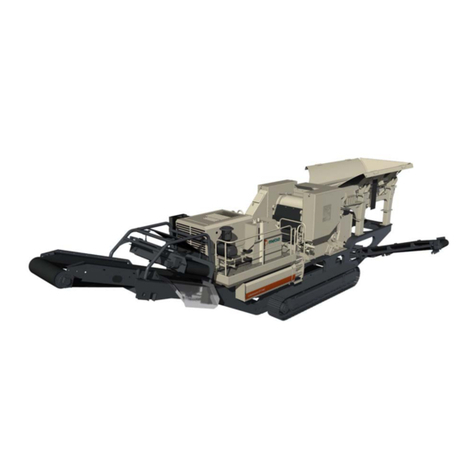
Metso
Metso LOKOTRACK LT110C User manual

Metso
Metso Nordtrack CT85 User manual
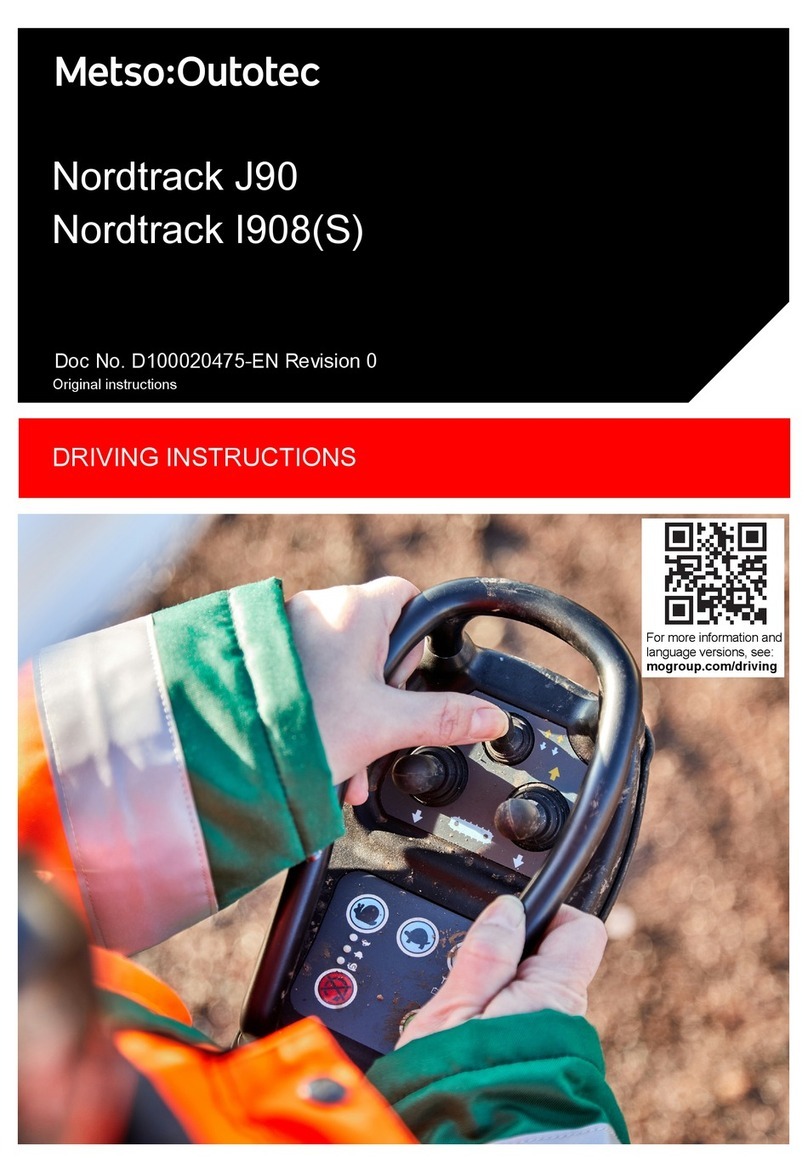
Metso
Metso Nordtrack J90 User manual
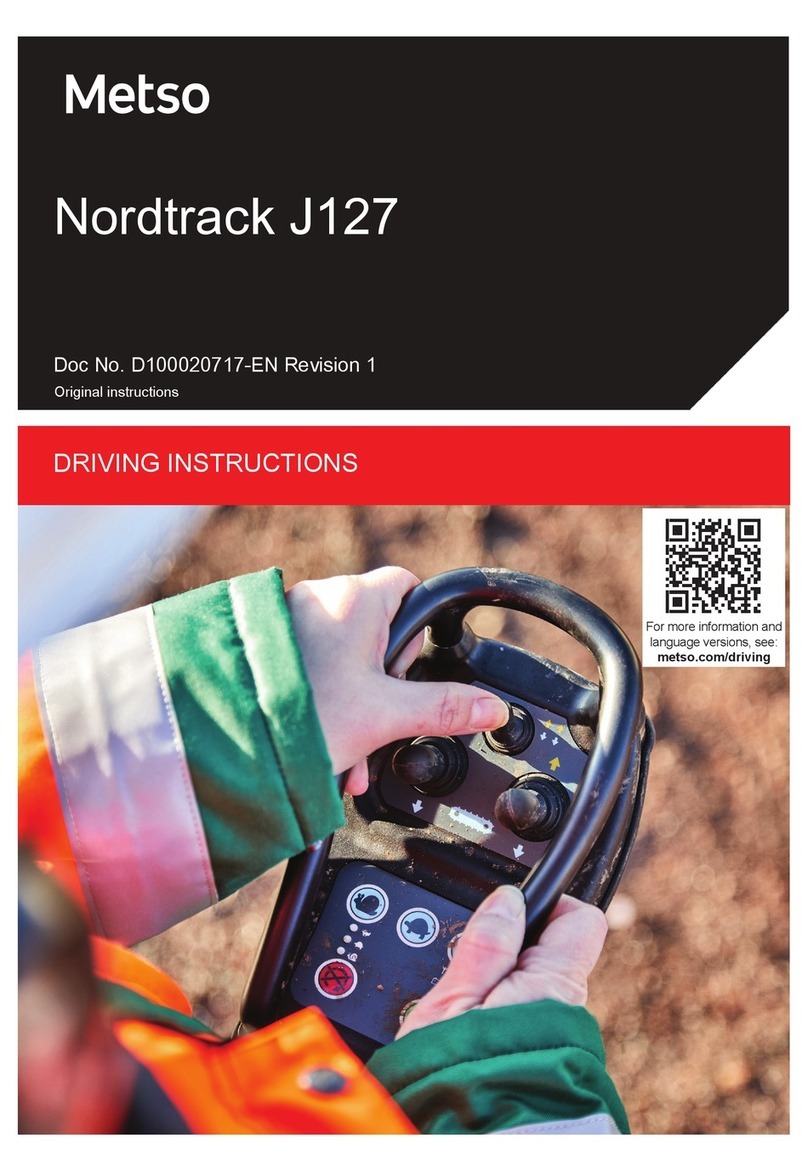
Metso
Metso Nordtrack J127 User manual
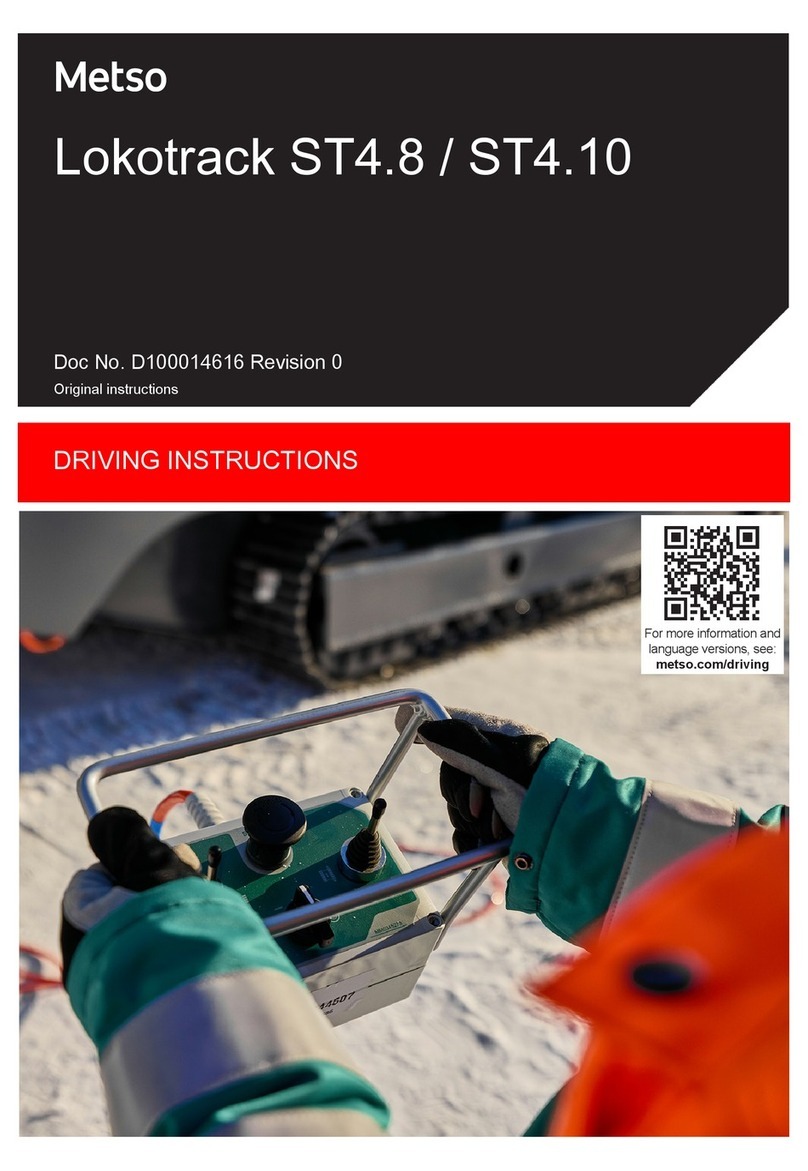
Metso
Metso Lokotrack ST4.8 User manual
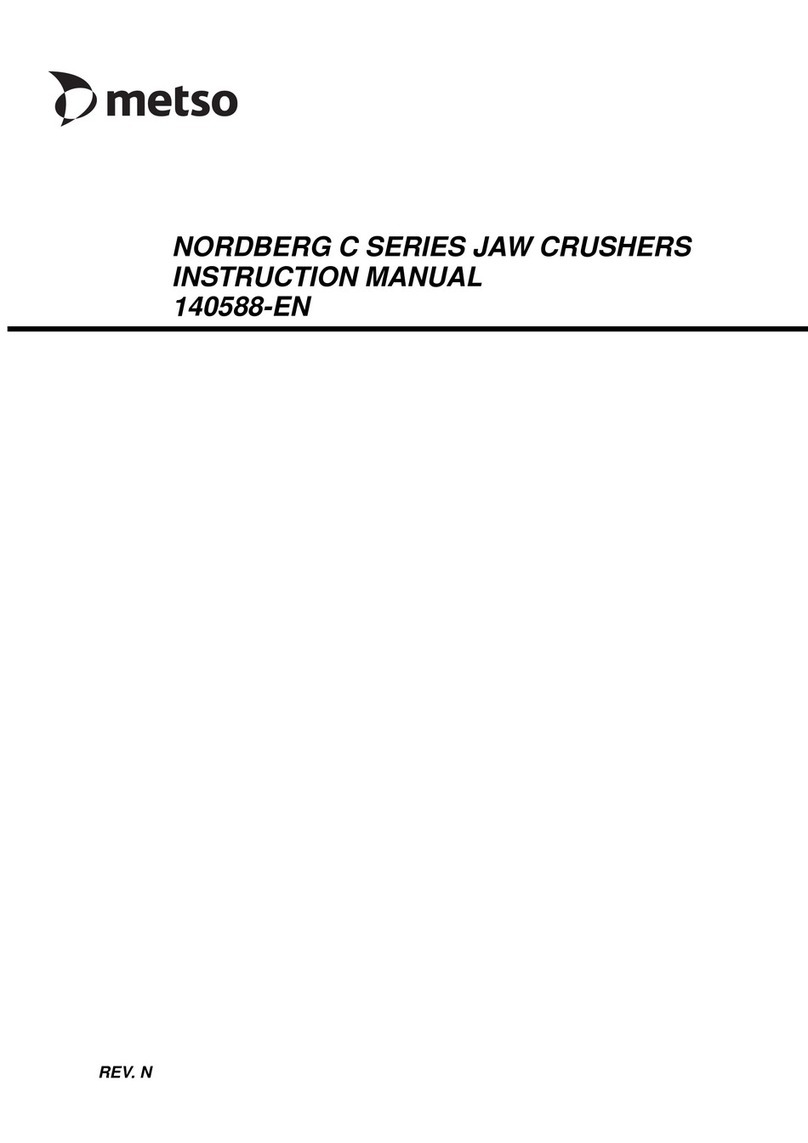
Metso
Metso NORDBERG C Series User manual
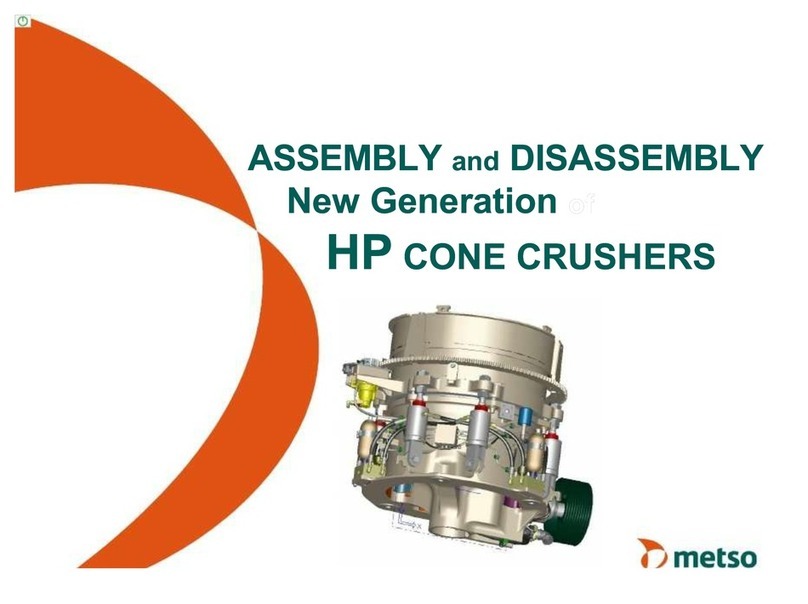
Metso
Metso HP Series Installation instructions
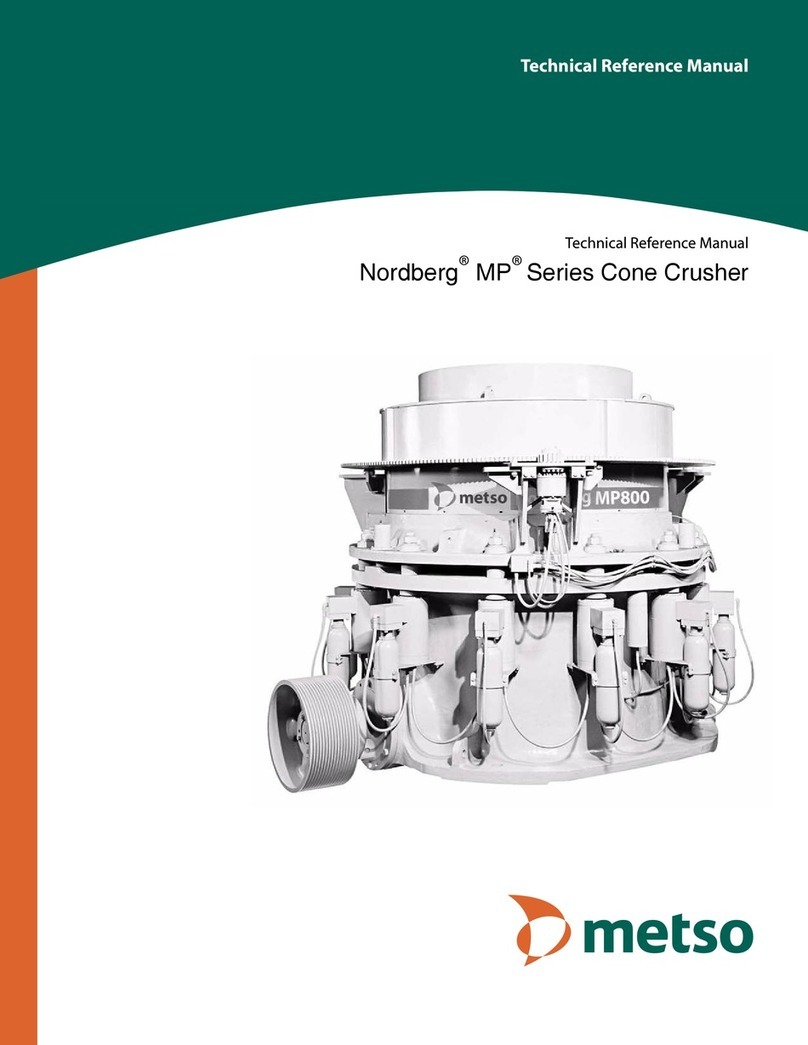
Metso
Metso Nordberg MP Series Product manual
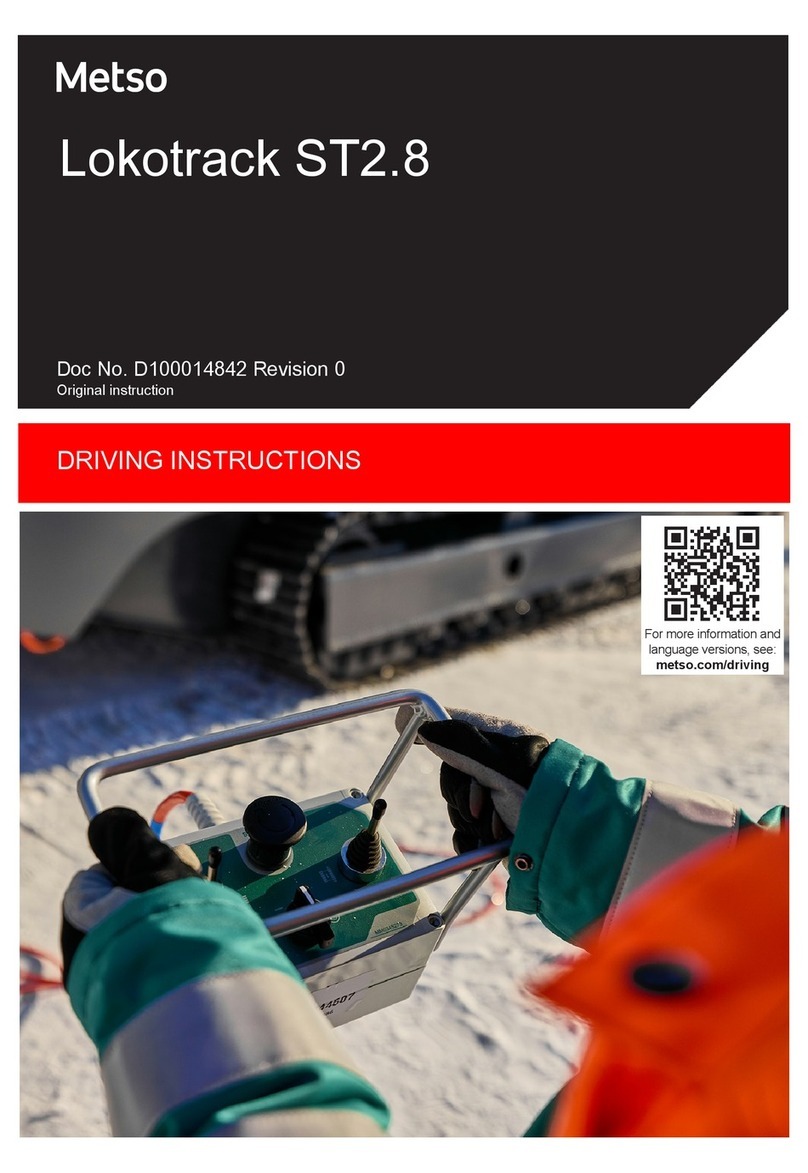
Metso
Metso Lokotrack ST2.8 User manual

Metso
Metso NORDBERG LT105 User manual

